Luxury real estate in Europe: A market trend analysis
The volume of real estate transactions related to luxury property has steadily increased from the turn of the Great Recession in 2011 to 2018. And with signs of a looming global economic slowdown, high-net-worth individuals (HNWIs) are looking to diversify their portfolio with non-traditional investments—as opposed to the standard set of equities and bonds—including luxury real estate.
To better understand the trends in the real estate purchases of HNWIs, international real estate platform Tranio conducted a survey in collaboration with Monaco International Luxury Property Expo 2019.
The joint survey helped to assess the opinions of property market experts—real estate agency representatives, developers, brokers, investors—on the prospects of luxury real estate as an investment vehicle, revealing the characteristics of luxury property buyers, including European hotspots for luxury property investment, popular property types, and investigating the main motivations behind their investments. This report provides highlights from the data compiled during the survey to help real estate professionals understand Europe’s current luxury real estate market landscape.
Europe and HNWIs
Europe has seen the greatest increase in the number of HNWIs —people holding at least $1M in assets— than in any other region around the world, according to Wealth-X’s “High Net Worth Handbook 2019”. The number of millionaires in Europe has increased year-by-year, accounting with approximate 5,71 million individuals in 2018 and according to Statista, it is forecasted to increase approximately 22% by 2023.
As Figure 1 shows below, Europe saw an increase of more than 4% of HNWIs in 2018, nearly 50% more than any other region. Europe also continues to stand strong as the destination of choice for the ultra-wealthy worldwide.
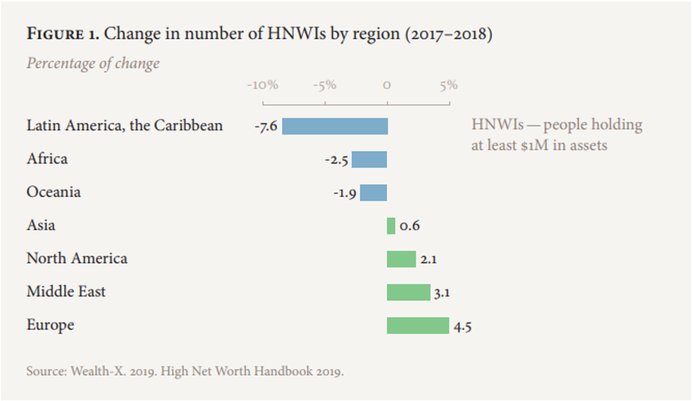
Who buys European luxury real estate?
With the growing number of HNWIs in Europe, it is not surprising that an increase in luxury real estate purchases has also been recorded. However, as seen in Figure 2 below, Tranio’s survey results show that despite the large numbers of international HNWIs purchasing property in Europe, the major players on the European luxury real estate are actually Western Europeans, followed by Russian nationals.
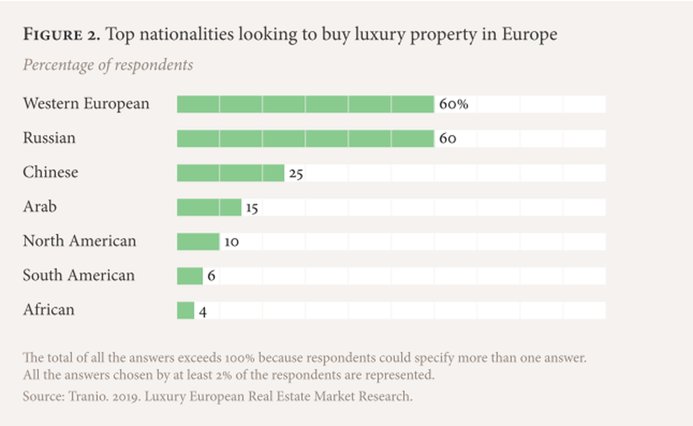
Among Western Europeans, as seen in Figure 3 below, UK nationals are the leading luxury real estate buyers (38% of respondents), followed by the German and Belgian nationals (15% each).
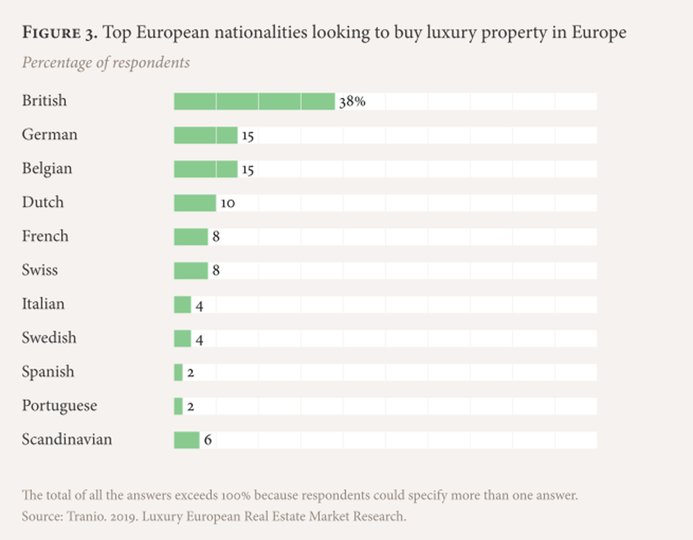
While British nationals are currently the most active buyers on the European luxury property market, Germany holds the highest number of ultra-high-net-wealth individuals (UHNWIs) in the world—individuals with at least $30M in private assets.
Tranio's survey correlates with the results from Knight Frank’s “The Wealth Report 2019”, suggesting that the UK and Germany took the European lead in the number of UHNWIs in 2019.
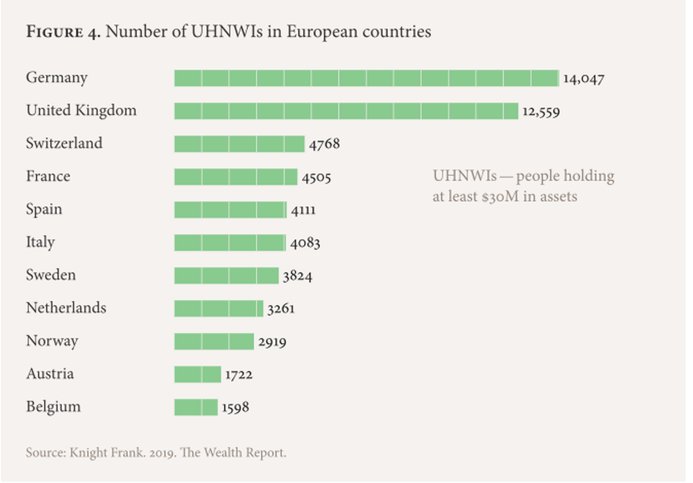
Additionally, Knight Frank predicts high growth dynamics for German UHNWIs of 25–30% by 2023, with a slightly lower growth of 20-25% expected in the UK in the next 5 years. As such, it is clear that the share of Germans buying luxury property is likely to increase significantly in the near future.
What European countries are most popular with luxury residential property buyers?
According to Tranio’s survey respondents, the most popular European countries for luxury property investment are Spain, the UK, Italy, and France. This data is corroborated by the results of Knight Frank's Wealth Report 2019, which agrees that Spain, the UK, and France are among the top four most attractive countries for luxury properties for Europeans, as well as Russians.
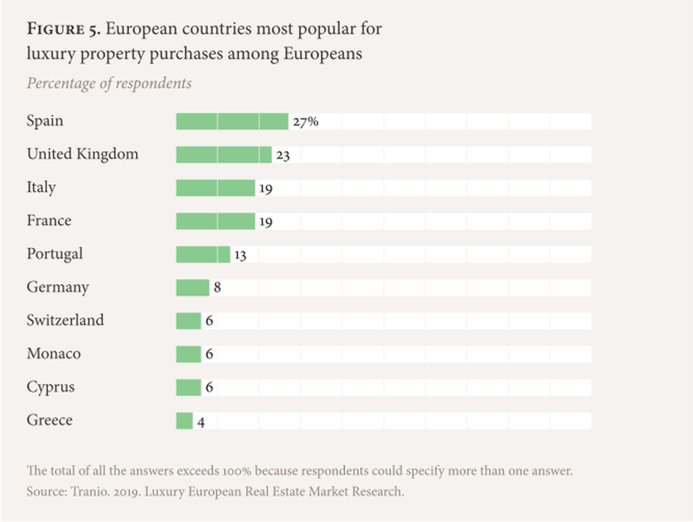
Why do investors buy European luxury real estate?
Investors buy luxury property in Europe for two main reasons: for leisure purposes - owning a holiday home that they can use during their free time and to earn an income. While the leading motivation is purchasing a holiday or second home, buying for investment—including both rental income and capital gains—is almost equally as strong, as seen below in Figure 6.
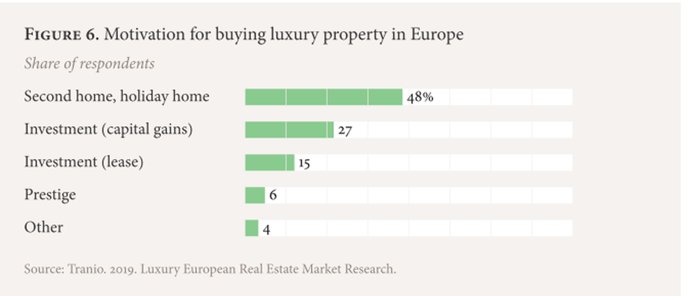
Also according to 65% of Tranio’s respondents, the number of individuals buying European luxury real estate for rental income has grown over the last 2–3 years.
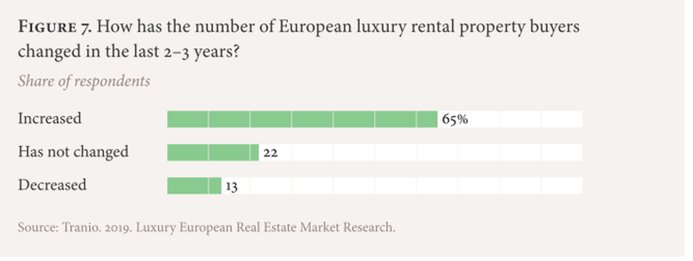
The purchase of luxury residential real estate in Europe has also been impacted by the demand for short-term rentals and the increasing popularity of micro-trips. Micro-travel—short trips of less than five days—is one of the hottest trends in the luxury travel market, according to the Luxury Travel Magazine. At the same time, Europe was also one of the dominant luxury markets for long-term holidays. In 2017 long-term holiday bookings accounted for 37% of the total luxury travel market, according to Adroit Global Luxury Travel Market Research. The global luxury travel market is expected to grow at an annual average rate between 4.6% and 7.4% over the next three years, which implies that seeking rental income from luxury real estate is an obvious choice for investors.
What are the common characteristics of luxury European rental properties?
As seen in Figure 8, most Tranio respondents reported that luxury real estate buyers looking for rental income prefer investing in apartments, with 61% of respondents stating that this property type is far more popular than villa. mansions or detached houses.
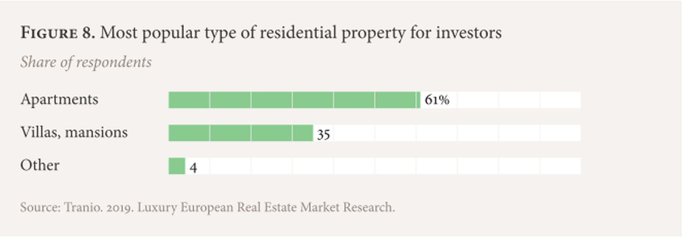
According to Sotheby’s International Realty Affiliates, significantly more luxury property buyers prefer residential property in central areas of cities rather than the suburbs: 31% prefer properties within the city limits, while 18% of the respondents chose to buy outside the city limits. The trend of buying apartments is also supported by Luxury Portfolio International report data: 38% of the respondents choose to be outside of city limits, while 59% chose to buy within.
Why has the number of off-plan luxury real estate purchases increased?
Tranio's survey has shown that at least 10% of European luxury residential property is bought off-plan or at the project development or start of construction stages. This situation may be due to the continuous luxury property price growth over the last five years, making it hard for investors to find relatively affordable stock on the market. With off-plan purchases, the price of the property is typically more affordable but it comes with manageable risks.
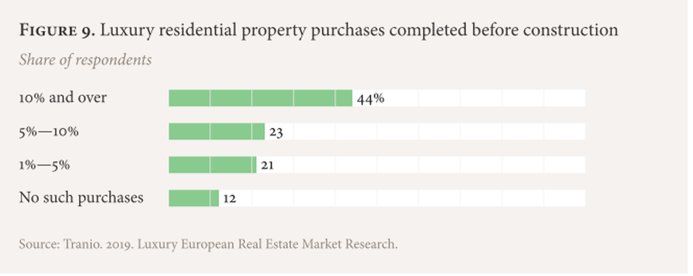
Further corroborating the popularity in off-plan buying, Figure 10 also demonstrates that the trend of buying property at the project development or start of construction stages has increased dramatically.
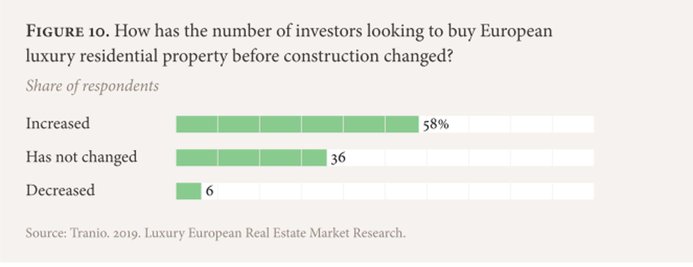
According to Knight Frank's Prime International Residential Index (PIRI 100)—a performance data index that monitors the most expensive properties in 100 of the key luxury cities and second-home markets—demand for luxury real estate has steadily increased, reaching a five-year peak in Q3 2018. While the data in Figure 11 shows that the demand for luxury property is still strong, it also validates the fact that investors are starting to look at off-plan luxury property investments.
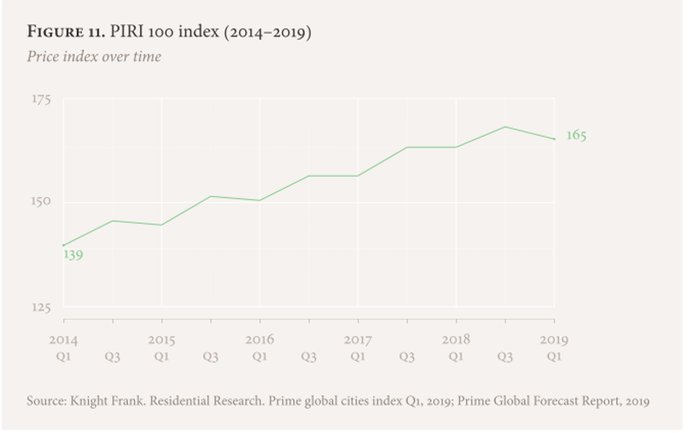
As seen in Figure 12, prices have grown in each quarter since Q1 2014, confirming that luxury real estate is still in high demand. While these rates remain positive, a declining trend in PIRI 100 growth rates has occurred since Q4 2017, suggesting that the luxury real estate market may have overheated with prices plateauing, further pushing demand for lower-priced, off-plan property.
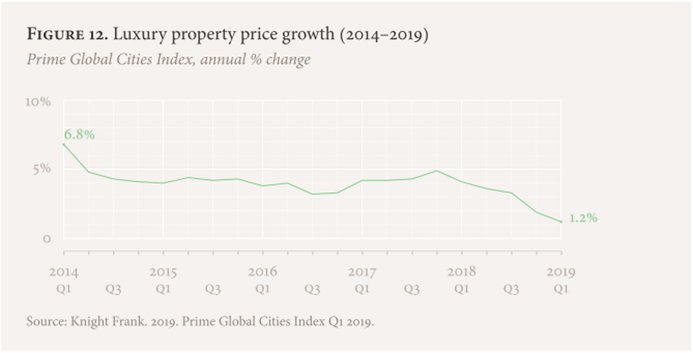
As noted by Knight Frank’s “Wealth Report” 47 of the 100 cities included in the PIRI 100 index are European. In 36 of these European cities in 2018, a year-on-year price increase was observed. Among these cities are capitals (Berlin, Paris, Amsterdam, Lisbon), large cities (Munich, Frankfurt) and upscale locations (Monaco, Cannes). Two notable exceptions are Oxford and London, where prices have declined (-3.9% and -4.4% respectively).
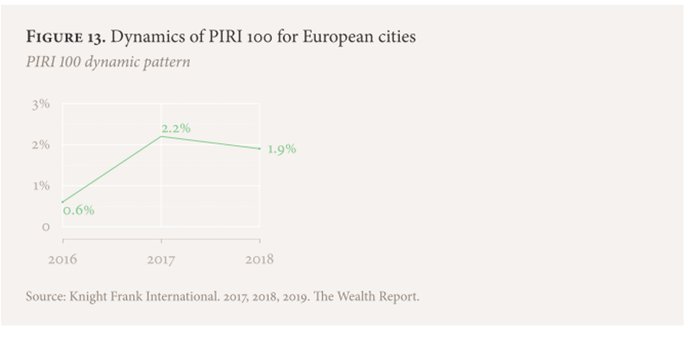
Summary
- According to Tranio’s survey respondents, buyers from Western Europe (60%) and Russia (also 60%) are the main players on the European luxury property market. This data coincides with the fact that there is an increase in the number of HNWIs in Europe
- Top 3 luxury real estate buyers among Europeans are British, Germans and Belgian nationals. The UK and Germany are also leaders in the number of UHNWIs in Europe, according to a study by Knight Frank
- A growth of 25-30% in the number of UHNWIs in Germany is forecasted over the next 5 years. In the UK, the growth forecast is lower at 20-25% over the same 5 years. We predict that this that the number of German luxury real estate buyers will also grow significantly in the next 5 years.
- Tranio’s survey results showed that the top 3 most popular European countries for luxury real estate investment are Spain (27% of respondents), Great Britain (23%), Italy (19%). These indicators correlate with the results of a similar survey conducted by Knight Frank.
- Luxury real estate is seen as both a “lifestyle” and an income-generating investment by the majority of the participants. 65% of the respondents indicated that the number of buyers seeking rental income from luxury real estate purchases has increased over the past 2-3 years.
- Luxury real estate buyers prefer central locations in cities rather than the suburbs. Only 38% of the respondents choose to be outside of city limits, while 59% chose to buy inside the city. This indicated by the Luxury Portfolio International agency report.
- 10% of all luxury real estate purchases are made at the project development stage or in the early stages of construction and projections show that these will continue to grow in the future.
We will send you a content digest not more than once a week